Aachen Cathedral, also known as the Kaiserdom (Imperial Cathedral) of Aachen, is one of the oldest churches in Germany. The cathedral is of great architectural, historical and religious importance. The Palatine Chapel is the remaining part of the palace of Charlemagne (German: Karl der Grosse) in Aachen. The chapel was built from 790 to 800. The chapel is a masterpiece of the Carolingian architecture, it was inspired by the byzantine church of San Vitale in Ravenna, Italy. The Palatine Chapel has been incorporated into Aachen Cathedral. In the 15th century, several chapels were added to the Palatine Chapel and it became Aachen Cathedral. Aachen Cathedral was on completion the largest cathedral north of the Alps. From 936 to 1531, Aachen Cathedral was the coronation church for thirty German emperors and kings. Aachen Cathedral houses treasures of the early medieval period, such as the throne of Charlemagne, a golden altar piece, a golden pulpit and golden shrines. A huge chandelier is hanging from the vault of the Palatine Chapel, the chandelier was gift from Emperor Frederick Barbarossa. The Shrine of the Virgin Mary and the Shrine of Charlemagne, which contains his mortal remains, are the most important treasures of Aachen Cathedral. The Shrine of the Virgin Mary contains the four great relics of Aachen Cathedral: the swaddling clothes of Jesus Christ, the loin cloth of Jesus Christ, the cloak of the Virgin Mary and the decapitation cloth of John the Baptist. These relics have made Aachen Cathedral an important pilgrimage destination for centuries, it became a meeting place for pilgrims along the Way of St. James to Santiago de Compostela in Spain, just like two other cathedrals and important pilgrimage destinations in Germany, Cologne Cathedral and Trier Cathedral. Aachen Cathedral gained the status as a UNESCO World Heritage in 1978.
www.werelderfgoedfotos.nl © Copyright World Heritage Photos
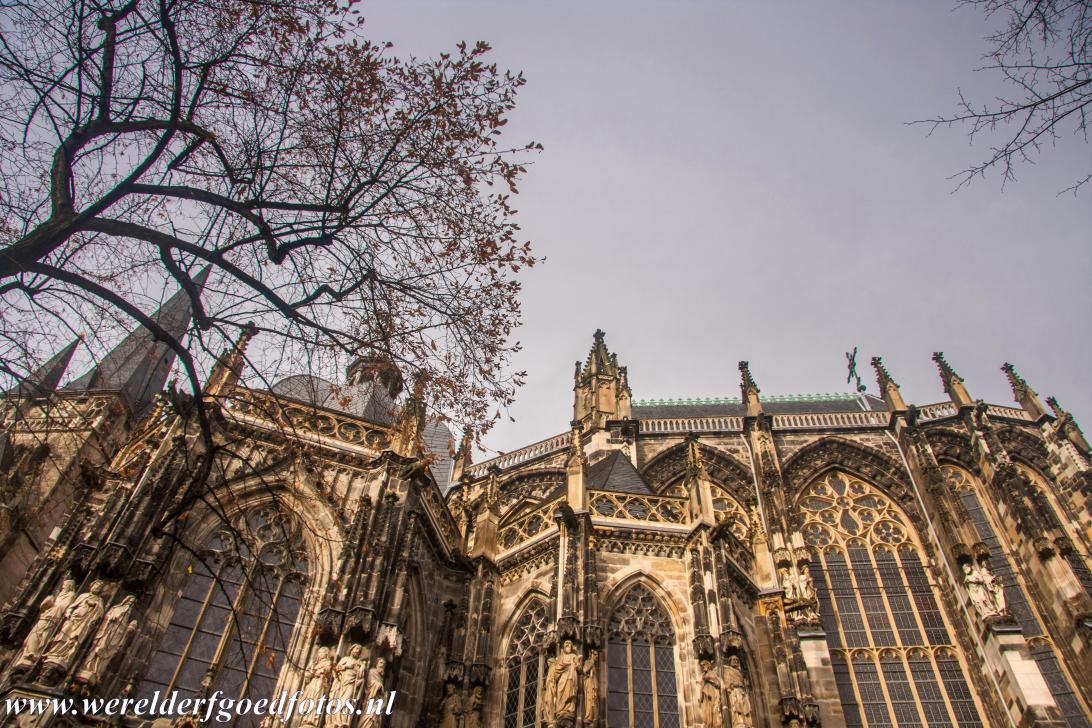
Aachen Cathedral: The Palatine Chapel is the remaining part of Charlemagne's palace in Aachen. The chapel has been incorporated into Aachen Cathedral. The Palatine Chapel is a masterpiece of Carolingian architecture, it was built by Charlemagne in 790-800. In the 15th century, a choir and chapels were added to the Palatine Chapel, the enlarged chapel became Aachen Cathedral.

Aachen Cathedral: The Palatine Chapel is the remaining part of Charlemagne's palace in Aachen. The chapel has been incorporated into Aachen Cathedral. The Palatine Chapel is a masterpiece of Carolingian architecture, it was built by Charlemagne in 790-800. In the 15th century, a choir and chapels were added to the Palatine Chapel, the enlarged chapel became Aachen Cathedral.
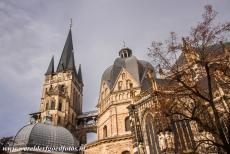
Aachen Cathedral: On the left the Hungarian Chapel and tower, on the right the octagonal dome of the Palatine Chapel. The bell tower houses eight bells. The bells were cast after the city fire in 1656. One of the bells, the Marybell, was replaced several times. The modern Marybell was cast in 1958, it is the largest bell and weighs 6045 kg. The bell tower was only complated in 1884.
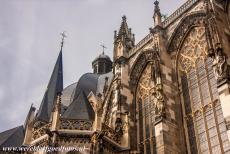
The exterior of Aachen Cathedral with the Palatine Chapel in the center, the chapel is the oldest part of the cathedral. The cathedral is one of the oldest Roman Catholic churches in the north of Europe. At the time of its completion, the cathedral was the largest cathedral north of the Alps. The Palatine Chapel is the final resting place of Charlemagne, Emperor of the Romans.
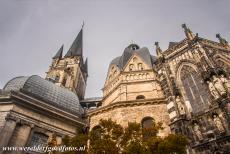
Aachen Cathedral was on completion the largest cathedral north of the Alps. Aachen Cathedral became an important meeting place for pilgrims along the famous Way of James to Santiago de Compostela in Spain. Pilgrims are able to see the Great Relics of Aachen Cathedral every seven year. Aachen Cathedral was inscribed on the UNESCO World Heritage List in 1978.
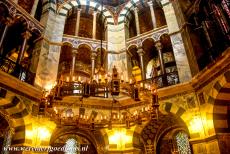
Aachen Cathedral: The Barbarossa Chandelier is hanging from the octagonal domed vault of the Palatine Chapel. The chandelier was donated to Aachen Cathedral in 1168 by Emperor Frederick Barbarossa to hang over the golden Shrine of Charlemagne. The large chandelier was made of gilt copper and is 4.2 meters in diameter.
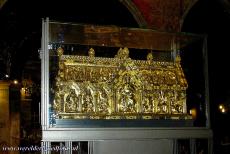
Aachen Cathedral: The Shrine of the Virgin Mary was completed in 1239. The shrine contains the four Great Relics of Aachen Cathedral: the swaddling clothes of Jesus, the loin cloth of Jesus, the cloak of the Virgin Mary and the decapitation cloth of the Jewish prophet John the Baptist, these great relics have made the cathedral an important pilgrimage destination for centuries.
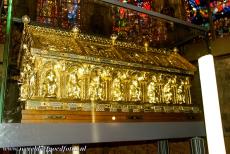
Aachen Cathedral: The golden Shrine of Charlemagne contains his mortal remains. The shrine was created in Aachen, ordered by the Roman Emperor Frederick II in 1182 and was completed in 1215. The Shrine of the Virgin Mary and the Shrine of Charlemagne are the most celebrated treasures of Aachen Cathedral. Aachen Cathedral is a main pilgrimage destination.
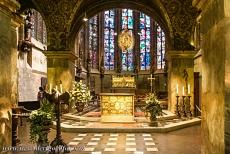
Aachen Cathedral: The main altar with the Pala d'Oro, the golden front. The Pala d'Oro dates from around 1020. It was a gift from the Holy Roman Emperor Otto III and his cousin Henry II. The golden panel depicts several scenes from the life of Christ, the Virgin Mary and Archangel Michael. Aachen Cathedral houses also a golden pulpit and golden shrines.
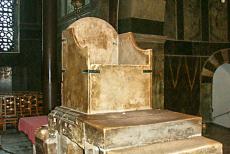
Aachen Cathedral: The marble throne of Charlemagne is located in the upper gallery. Between 936 and 1531, the cathedral was the coronation site for thirty one German kings and emperors. The marble slabs of the throne came from the Church of the Holy Sepulcher in Jerusalem. The throne was made around 800, in the Carolingian period.
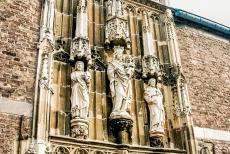
Statues above the entrance to the Aachen Cathedral Treasury, the treasury is one of the most important ecclesiastical treasuries in Northern Europe, it houses more than hundred sacral art treasures, among them the Gothic silver-gilt Bust of Charlemagne, the Ottonian Cross of Lothair, the Persephone Sarcophagus and an arm reliquary, containing bones from Charlemagne's right arm. The treasury is part of the UNESCO World Heritage Aachen Cathedral.
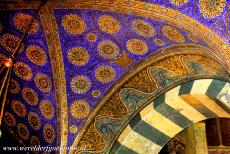
Aachen Cathedral: The vaulted ceiling of the octagonal Palatine Chapel is adorned with mosaics. the mosaics were inspired by the Byzantine mosaics from the 5th and 6th centuries in Ravenna. During WW I and WW II, the cathedral suffered relatively little damage. Aachen Cathedral gained the status as a UNESCO World Heritage in 1978.
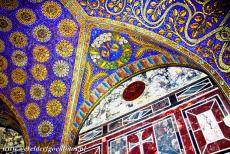
Aachen Cathedral: The Palatine Chapel is octagonal in shape, it is surrounded by arcades and a number of chapels. The vaults are decorated with mosaics. The Palatine Chapel was inspired by the Byzantine church of San Vitale in Ravenna (see also the World Heritage Photos of Ravenna in Italy). Aachen Cathedral is one of the oldest churches in Germany.
